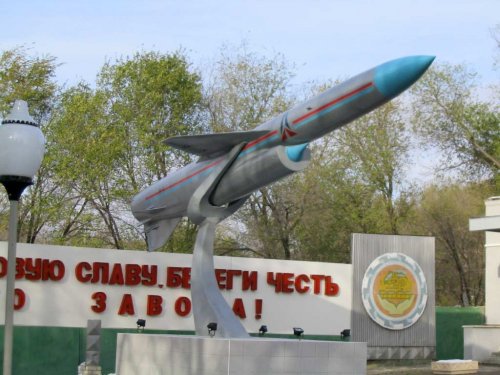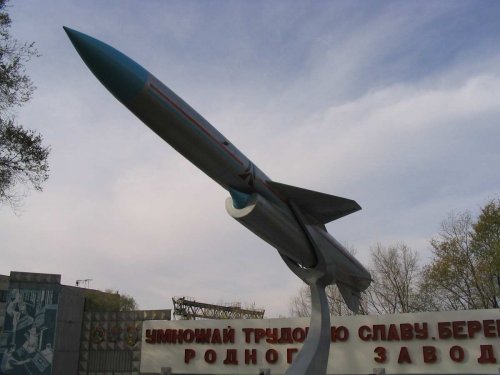You are using an out of date browser. It may not display this or other websites correctly.
You should upgrade or use an alternative browser.
You should upgrade or use an alternative browser.
Vulcan P-1000
- Thread starter rousseau
- Start date
Tuomasn
ACCESS: Secret
- Joined
- 5 January 2006
- Messages
- 477
- Reaction score
- 358
Re: Vulcan П-1000
From my files...
P-1000 Vulkan (3M70)
Type: Anti-ship cruise missile
Designer: Chelomey
Maximum Range: 700 km
Maximum Speed: Mach 1.7
Propulsion: Solid-propellant rocket booster + turbojet sustainer
Guidance: Command + active or passive radar terminal homing
Fire Control: Argon-KV radar + Kasatka-B SATCOM
Warhead: HE or nuclear
Platforms: Pr.675MKV, Pr.1164
The development of the P-1000 Vulkan was ordered by a decree of 17 May 1979 as a successor to the P-700 Granit. It was derived from the P-500 missile but had a more powerful and efficient turbojet sustainer, a more powerful rocket booster, and made extensive use of titanium in its construction. Submarines had to surface to launch the missile. The first submarine test launch was made in December 1983. Four Echo II -class SSGNs (K-1, K-22, K-34, K-35) were rebuilt to launch the P-1000 in the late 1980s, and it was also to be fitted to the fourth Slava-class cruiser Admiral Lobov. A fifth Echo II conversion (K-10) was never finished, and the four submarines were retired in the mid-1990s.
From my files...
P-1000 Vulkan (3M70)
Type: Anti-ship cruise missile
Designer: Chelomey
Maximum Range: 700 km
Maximum Speed: Mach 1.7
Propulsion: Solid-propellant rocket booster + turbojet sustainer
Guidance: Command + active or passive radar terminal homing
Fire Control: Argon-KV radar + Kasatka-B SATCOM
Warhead: HE or nuclear
Platforms: Pr.675MKV, Pr.1164
The development of the P-1000 Vulkan was ordered by a decree of 17 May 1979 as a successor to the P-700 Granit. It was derived from the P-500 missile but had a more powerful and efficient turbojet sustainer, a more powerful rocket booster, and made extensive use of titanium in its construction. Submarines had to surface to launch the missile. The first submarine test launch was made in December 1983. Four Echo II -class SSGNs (K-1, K-22, K-34, K-35) were rebuilt to launch the P-1000 in the late 1980s, and it was also to be fitted to the fourth Slava-class cruiser Admiral Lobov. A fifth Echo II conversion (K-10) was never finished, and the four submarines were retired in the mid-1990s.
DTIG report on Russian and Soviet missiles. Very interesting read. How much is accurate?
http://www.dtig.org/docs/Russian-Soviet%20Naval%20Missiles.pdf
RP1
http://www.dtig.org/docs/Russian-Soviet%20Naval%20Missiles.pdf
RP1
M. A. Rozon
ACCESS: Confidential
- Joined
- 17 February 2007
- Messages
- 121
- Reaction score
- 75
In fact, it was based on Bazalt. Here is what the "Naval Institute Guide to World Naval Weapons Systems Fifth Edition (2006-2007)" says about it:
" A successor P-1000/3M70 (Vulkan, which is SS-N-12 Mod 2) is largely a Bazalt airframe with new electronics. The designation suggests a much improved P-500, just as Link 22 is an improved replacement for Link 11. Reportedly, its warhead was armoured (with Titanium) against CIWS rounds, and some steel parts were replaced by titanium to cut weight. It had a more powerful engine and a more powerful booster; better fuel economy extended range range to 700 km.
Reported details;
launch weight 4.5 tons with 1000 kg warhead
speed mach 2.3
length 11.6 metres
minimum flight atitude 40 metres
Reportedly, development was approved by the Council of Ministers on May 15, 1979; land trials began in July, 1982, followed by a submarine trial, from an Echo II submarine, on December 22, 1983. Although the five Echo II submarines armed with this weapon have been discarded, it survives aboard Slava class cruisers, having replaced Bazalt."
Hope this helps. Although a little pricey, fifth edition has lots of interesting info on Soviet/Russian stuff. I found my copy on for half price with a damaged cover but otherwise in excellent condition, and the rest is history.
" A successor P-1000/3M70 (Vulkan, which is SS-N-12 Mod 2) is largely a Bazalt airframe with new electronics. The designation suggests a much improved P-500, just as Link 22 is an improved replacement for Link 11. Reportedly, its warhead was armoured (with Titanium) against CIWS rounds, and some steel parts were replaced by titanium to cut weight. It had a more powerful engine and a more powerful booster; better fuel economy extended range range to 700 km.
Reported details;
launch weight 4.5 tons with 1000 kg warhead
speed mach 2.3
length 11.6 metres
minimum flight atitude 40 metres
Reportedly, development was approved by the Council of Ministers on May 15, 1979; land trials began in July, 1982, followed by a submarine trial, from an Echo II submarine, on December 22, 1983. Although the five Echo II submarines armed with this weapon have been discarded, it survives aboard Slava class cruisers, having replaced Bazalt."
Hope this helps. Although a little pricey, fifth edition has lots of interesting info on Soviet/Russian stuff. I found my copy on for half price with a damaged cover but otherwise in excellent condition, and the rest is history.
sferrin said:The part that's really cool/deadly about it is it dives in the water right before impact so as to hit below the waterline.
Thus creating a depression underneath the ship making it collapse onto itself. Was allready used by German torpedoes of some sort in WW2 if I recall correctly. Much more efficient than direct hits.
M. A. Rozon
ACCESS: Confidential
- Joined
- 17 February 2007
- Messages
- 121
- Reaction score
- 75
In answer to shkval, both Bazalt and Vulcan share the same flight profile; high-low.
As noted in the DTIG pdf above, a salvo of up to eight missiles is fired. One of the missiles flies at between 5000 and 7000 metres as a "scout" while the others fly at a "medium" altitude (probably about 2000-3000 metres. The scout uses its active radar to search the target area. It communicates with the other missiles in the salvo and the firing ship (through Front Door/Trap Door) which assists in designating the primary target). The missiles then distribute targets between themselves with the primary target getting half of the salvo. If the scout is shot down before this occurs, another missile in the salvo climbs to take its place.
Once the target is designated and future target position calculated, the scout goes silent and all of the missiles descend to the 40 metre altitude. All missiles stay silent until they get above the calculated radar horizon of the targets when they switch on, lock on and attack.
Additional penetration aids in Bazalt, besides the use of armour, include a self defense jammer.
SS-N-19 Shipwreck (Granit) operates similarly but has some more sophisticated features. One very big difference is that once launched it no longer communicates with the firing ship; the scout missile assigns targets by itself.
As for the diving attack under the waterline, this mode of attack has its advantages but is more difficult to execute. Early Soviet anti-ship missile projects tried to achieve this but were unsuccessful. The Soviets then decided that it was better to at least get the hit reliably hence they struck the target above the waterline in a dive. When attacking a carrier, this had the advantage of striking the flight deck and/or hangar, achieving a mission kill if not at an outright one. As for Bazalt and Vulcan, russian-language sources I have on hand make no reference to this mode of operation (although my russian is certainly not perfect!). I would appreciate a source in addition to the DTIG pdf listed above to substantiate this claim as I think it may be in error.
I do know without doubt that SS-N 3 (P-6 and P-35) antiship missiles struck above the waterline. I have a very interesting picture of the aftermath of a P-35 test shot without a warhead; the missile made an almost perfect front view silhouette in the part of the superstructure where it struck the target. This appears to contradict the claim of underwater attack made in the dtg doc for this missile.
Thanks in advance.
8)
As noted in the DTIG pdf above, a salvo of up to eight missiles is fired. One of the missiles flies at between 5000 and 7000 metres as a "scout" while the others fly at a "medium" altitude (probably about 2000-3000 metres. The scout uses its active radar to search the target area. It communicates with the other missiles in the salvo and the firing ship (through Front Door/Trap Door) which assists in designating the primary target). The missiles then distribute targets between themselves with the primary target getting half of the salvo. If the scout is shot down before this occurs, another missile in the salvo climbs to take its place.
Once the target is designated and future target position calculated, the scout goes silent and all of the missiles descend to the 40 metre altitude. All missiles stay silent until they get above the calculated radar horizon of the targets when they switch on, lock on and attack.
Additional penetration aids in Bazalt, besides the use of armour, include a self defense jammer.
SS-N-19 Shipwreck (Granit) operates similarly but has some more sophisticated features. One very big difference is that once launched it no longer communicates with the firing ship; the scout missile assigns targets by itself.
As for the diving attack under the waterline, this mode of attack has its advantages but is more difficult to execute. Early Soviet anti-ship missile projects tried to achieve this but were unsuccessful. The Soviets then decided that it was better to at least get the hit reliably hence they struck the target above the waterline in a dive. When attacking a carrier, this had the advantage of striking the flight deck and/or hangar, achieving a mission kill if not at an outright one. As for Bazalt and Vulcan, russian-language sources I have on hand make no reference to this mode of operation (although my russian is certainly not perfect!). I would appreciate a source in addition to the DTIG pdf listed above to substantiate this claim as I think it may be in error.
I do know without doubt that SS-N 3 (P-6 and P-35) antiship missiles struck above the waterline. I have a very interesting picture of the aftermath of a P-35 test shot without a warhead; the missile made an almost perfect front view silhouette in the part of the superstructure where it struck the target. This appears to contradict the claim of underwater attack made in the dtg doc for this missile.
Thanks in advance.
8)
- Joined
- 1 April 2006
- Messages
- 11,390
- Reaction score
- 10,278
Similar threads
-
-
UGM-89 Perseus STAM (Submarine Tactical Missile)
- Started by Triton
- Replies: 9
-
-
-
Request for info on Soviet 'M-61 supersonic cruise missile' please??
- Started by Pioneer
- Replies: 2


